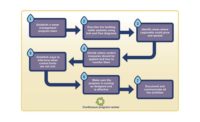Most plumbing engineers involved in healthcare design who I’ve talked to have said their foremost design concern is waterborne bacterial control in general, and legionella in particular.
That concern is well-warranted due to the 5.5 times increase of Legionnaires’ disease cases in the U.S. since 2000, reported by the Centers for Disease Control and Prevention. Hospital owners and operators are also increasingly concerned with waterborne bacteria, as it may account for at least 80,000 cases and $2 billion in Medicare payments annually. The CDC estimates that 85% of all Legionnaires’ disease outbreaks arose from contaminated water systems and could have been prevented by effective water management programs.
Stemming from the statistics mentioned above, and the negative publicity around them, several different legionella control standards have been written in response. ANSI/ASHRAE Standard 188 - Legionellosis: Risk Management for Building Water Systems is one that is particularly important for plumbing, HVAC and healthcare building engineers and owners to understand.
The Centers for Medicare & Medicaid Services Mandate Ref: S&C 17-30, issued in June 2017, requires all Medicare- and Medicaid-participating hospitals, critical access hospitals, and long-term care facilities to immediately implement ASHRAE 188- and CDC-compliant water management programs. And while not all healthcare facilities are currently required to develop water management programs, U.S. legislation and health authorities seem to be moving in that direction.
The requirements of ASHRAE 188 provide a foundation for developing a building water management program, focusing on identifying, monitoring and controlling risk-prone elements of the water systems. It’s important to note that the standard establishes a greater degree of accountability for legionella prevention and management on the building owner than on the designer. Nevertheless, it is still imperative that plumbing and HVAC engineers understand the requirements to educate clients about developing a program, managing risks, performing maintenance and implementing action plans if an outbreak occurs. This two-part series condenses the material in the standard and focuses on the major points. It is not a substitute for reading the full text, available for purchase on the ASHRAE website.
Identifying risks
Having an understanding of how legionella grows and attacks helps in understanding why ASHRAE 188 focuses on the risk factors it does. Legionella’s ideal growth environment is warm (see Figure 2) stagnant water, although it can grow in less-than ideal conditions. The respiratory infections it causes — Legionnaires’ disease and Pontiac fever — are triggered by inhalation of contaminated water droplets. It prefers to attack people with weaker immune systems such as the elderly, those afflicted with another chronic disease, or those recovering from severe injuries or invasive surgery. The legionellosis risk factors listed in ASHRAE 188 take all of this into account, though they do not encompass all design elements that may carry a heightened risk.
ASHRAE 188 first requires design engineers and building owners to conduct a building survey to determine if legionellosis risk factors are present. The survey must be completed prior to occupancy of a new building or prior to construction of a renovation. If risk factors are present, the building owner is required to develop and implement a water management program.
Legionellosis risk factors may be present in elements of the building’s plumbing and HVAC water systems. But they may also be present by the nature of the building occupants, particularly if they have acute or chronic medical conditions or are immunocompromised. The standard requires the conditions in the following table to be identified and documented if they are present, as they carry elevated risks of legionellosis.
If any of the building water system elements listed are present, they must each meet the water management program and maintenance requirements of the standard. However, if any of the building and occupant conditions are present, then all potable building water systems in addition to the system elements listed in the table are subject to the requirements. Once the survey is complete, and it is established that a water management program is required, the next step is to develop and implement the program.
In the second part of this series, I will discuss how to develop and implement an ASHRAE 188 water management program based on the building survey findings.





